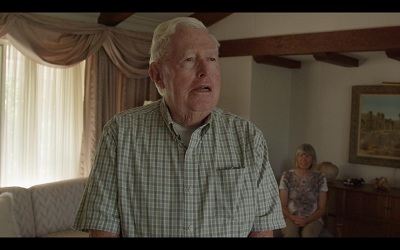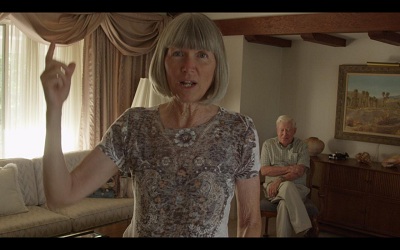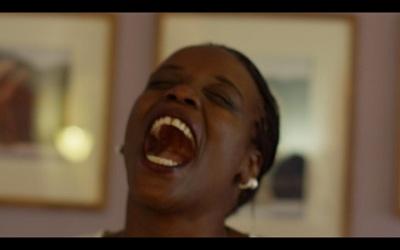Something intangible yet unmistakable in Ndinda Spada’s oral history piqued the interest of artist Nicole Miller. Spada had visited the LACMA9 Art+Film Lab when it was in San Bernardino and recorded a personal story during the Lab’s drop-in oral history hours. It was a short video, just five minutes, but in it Spada spoke passionately about moving to California from Kenya, and how she found a surrogate family in her church.
LACMA commissioned Miller to mine interviews collected in the nine cities on the Lab’s tour in order to identify subjects for new artworks. Miller sensed an open and expressive quality in Spada, something that transmitted through the video recording. “It’s pretty clear when I meet someone whether or not they are interested in going through this journey with me. Everyone who came to the Lab to tell their story all had an air of wanting to share. I didn’t know Ndinda would be such a good performer, but I had a feeling.”
 Nicole Miller, still from video series Believing is Seeing, featuring Redlands resident Ndinda Spada
Nicole Miller, still from video series Believing is Seeing, featuring Redlands resident Ndinda Spada
The journey that Miller describes could be summed up as an exploration of self-representation. Miller is not a documentarian, and LACMA’s charge was not to create a series of photojournalistic biographies representing the sites that compose the LACMA9 initiative. Rather, Miller regularly uses documentary practice to “give people space to self-represent.” Some of the circumstances depicted in past work include a man recalling the amputation of his arm, young people dancing explicitly at a club, a conductor performing, and a yogi engaged in transcendental meditation.
 Nicole Miller, still from The Conductor, recently acquired by LACMA
Nicole Miller, still from The Conductor, recently acquired by LACMA
According to Miller, her videos document “individuals making a decision about how to represent themselves.” Miller posits that self-representation is mired, subconsciously or not, in tropes learned from outlets such as cinema. This history of representation has contributed to our collective understanding of how to present ourselves to the world. In this way, identity can be more akin to performing a character than revealing a truth.
At the same time, Miller’s work often captures what she refers to as “sublime subjectivity,” where her subjects seem to temporarily eschew this loaded history, the implication of the camera, and the forthcoming audience. By reliving trauma, executing physical acts, or engaging in forms of personal expression in front of the camera lens, Miller’s subjects seem to momentarily thwart the conventions of representation, attaining disarming veracity.
 Nicole Miller, still from video series Believing Is Seeing, featuring Redlands residents Harold Hartwick and Diana Kriger
Nicole Miller, still from video series Believing Is Seeing, featuring Redlands residents Harold Hartwick and Diana Kriger
The artist further investigates this concept through the LACMA9 commission. After viewing the brief oral history that Spada recorded in the Lab, Miller conducted research and discovered that, in addition to Spada’s involvement with her church, she teaches hasyayoga, or laughter yoga. Miller contacted the Redlands resident to collaborate on a video artwork that would feature her at church and demonstrating hasyayoga techniques. “Usually when I tell people the concept behind the work, they start to see themselves in relationship to my ideas. We (Spada and I) met together knowing exactly what we were looking for. In this way it feels less like a documentary and more like a performance. What can one know about another based on one story besides that story, besides that one gesture?” The result is a compelling portrait that reflects on the display of identity through faith, therapy, and self-representation.
 Nicole Miller, still from video series Believing Is Seeing, featuring Redlands residents Diana Kriger and Harold Hartwick
Nicole Miller, still from video series Believing Is Seeing, featuring Redlands residents Diana Kriger and Harold Hartwick
Miller’s video artwork featuring Spada and other Redlands community members is the first in an evolving series of works titled Believing is Seeing. “I stole the title from a book, which in a way I suppose is a gesture undercutting the validity of originality and subjectivity at the same time as pursuing it.” The Redlands component of Believing Is Seeing debuts in the Bing Theater on Sunday, October 13, looping from 12:30 to 2:30 pm, with Nicole Miller in attendance. The author also selected the documentary Burden of Dreams to directly follow the viewing.
Sarah Jesse, associate vice president, Education



